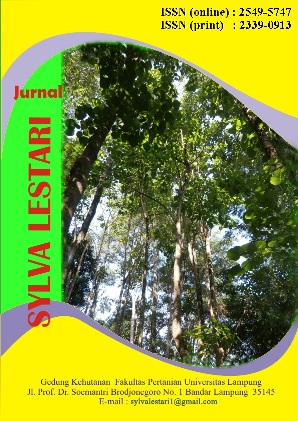The Diversity Amphibian (Order Anura) on Diefferent Habitat Types in Balik Bukit Resort Bukit Barisan Selatan National Park
DOI:
https://doi.org/10.23960/jsl1659-66Abstract
Balik Bukit Resort Bukit Barisan Selatan National Park (BBSNP) is a protected area where various amphibians habitat. The conditions and quality of habitat, of course determines the diversity of amphibians. This study aimed to analyze the diversity to detect that the
amphibians (order Anura), comparing the diversity of amphibians (order Anura) based on different types of habitat and identifying amphibian habitat conditions (order Anura) in Resort Balik Bukit of Bukit Barisan Selatan National Park. This study uses three replications in each habitat type (primary forest, bush and swamp) and using Visual Encounter Surveys in amphibian biodiversity data retrieval. The data have been analyzed using the Shannon Wiener index, and community similarity index by calculating the evenness. Research shows that the value of diversity is still classified as being on the three types of habitat with the highest diversity found in primary forest habitat that habitat conditions in Resort Behind the hill is still ensure the growth and proliferation of amphibians order Anura.
Keywords: Anura, Amphibians, Environmental Indicators, Resort Balik Bukit TNBBS
Downloads
Downloads
Published
How to Cite
Issue
Section
Statistics
 Abstract views: 475 times
Abstract views: 475 times PDF downloaded: 347 times
PDF downloaded: 347 times
Metrics
License
Copyright (c) 2018 Roly Mardinata, Gunardi Djoko Winarno, Nuning Nurcahyani

This work is licensed under a Creative Commons Attribution-NonCommercial 4.0 International License.
Authors retain copyright and grant the journal right of first publication with the work simultaneously licensed under a Creative Commons Attribution-NonCommercial 4.0 Licence that allows others to share the work with an acknowledgement of the work's authorship and initial publication in this journal.
Authors are able to enter into separate, additional contractual arrangements for the non-exclusive distribution of the journal's published version of the work (e.g., post it to an institutional repository or publish it in a book), with an acknowledgement of its initial publication in this journal.
Authors are permitted and encouraged to post their work online (e.g., in institutional repositories or on their website) prior to and during the submission process, as it can lead to productive exchanges, as well as earlier and greater citation of published work (See The Effect of Open Access).









